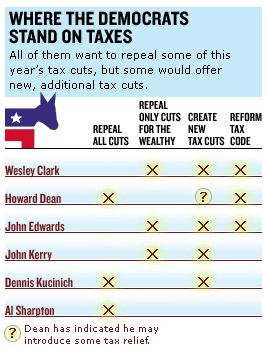NEW YORK (CNN/Money) -
In thinking about the implications of the 2004 presidential election, economists and analysts on Wall Street have been handicapping President Bush against Senator John Kerry, his most likely Democratic opponent.
But at least one other Democratic candidate, Sen. John Edwards of North Carolina, is still given a decent chance by many political analysts to take his party's nomination, and his economic policies differ somewhat from Kerry's.
| Undecided?
|

|
|
|
|
Two other candidates, retired Gen. Wesley Clark and former Vermont Gov. Howard Dean, are still breathing in the campaign, but their chances of winning the Democratic nomination seem, for now at least, much slimmer than Kerry's or Edwards'.
In any event, there are clear differences between Bush and the two front-running Democrats:
- Bush wants to make the tax cuts passed in 2001, 2002 and 2003 permanent. Edwards and Kerry would repeal those cuts that benefit the wealthy (though their definition of "wealthy" varies)
- Bush would privatize Social Security, at least partially. The other candidates oppose privatization
- Bush would privatize some health-care coverage, as well, through health savings accounts and similar measures. Edwards and Kerry both propose combinations of government spending and tax breaks to extend health-care coverage
- Edwards and Kerry would require future trading partners to meet labor and environmental standards, which Bush opposes
- Edwards and Kerry want to raise the minimum wage and extend federal temporary unemployment benefits, measures also opposed by Bush
From there, the differences between the two Democrats are a matter of nuance, but they are worth noting.
Tax policies
Kerry wants to roll back tax cuts for families earning more than $200,000 a year. But he wants to keep the higher child tax credit, the lower marriage penalty and the new 10 percent tax bracket for lower-income families. He also calls for new tax credits for health care and college tuition.

Edwards has similar ideas, but has so far offered greater detail. He would repeal tax cuts -- including dividend and capital-gains cuts -- for what he says are the top 2 percent of Americans, those making $240,000 or more a year.
Edwards would also keep the tax on very large estates, and he would set the top rate on capital gains at 25 percent for families earning more than $350,000, which he says represents less than 1 percent of all Americans.
Furthermore, Edwards would adjust the tax code so that the top 1 percent pay the same tax rate on investment income as middle-class families pay on regular income, to fix what he calls the "two tax systems" in America, "where a millionaire investor sitting by his swimming pool pays a lower tax rate than a Manchester teacher."
Like Kerry, Edwards would keep in place the latest middle-class tax cuts and introduce more breaks, including:
- a $5,000 credit for first-time home buyers
- a $1,000 credit for savings accounts
- a cut in the capital-gains tax rate, along with allowing the first $1,000 in capital gains and the first $500 in dividends to be tax-free
Economists are divided about the impact of rolling back tax cuts for the wealthy. Supporters of the cuts say structural changes in the economy have made small businesses and sole proprietors more important than ever for job creation and economic growth.
| Related stories
|

|
|
|
|
In order to avoid the hassles of incorporation, many of these entrepreneurs file taxes as individuals, these supporters say, meaning that raising their taxes could force them to hire fewer workers and slow down investment.
Others doubt that argument and suggest there are better ways to help small businesses. Edwards, for example, has proposed a plan to give venture capital to small firms and entrepreneurs in poor communities.
Slight differences on trade, jobs
Kerry and Edwards are also similar in their approach to trade, though Edwards has lately criticized Kerry for voting for NAFTA. Edwards, who often refers to the fact that his parents worked in textile mills, blames NAFTA for the disappearance of many U.S. mill jobs. But he has not proposed repealing the trade agreement, which was pushed by President Clinton.
Both Kerry and Edwards would keep current trade agreements but promise to enforce them more vigorously. Kerry takes the extra step of promising a 120-day review of all current agreements to make sure trading partners meet environmental and labor standards.
Both have also promised to repeal corporate tax breaks for companies that move jobs offshore, and both would give new incentives for manufacturers who hire U.S. workers.
More than 2.4 million jobs have been lost since February 2001, a month before the last recession began, marking the longest stretch of joblessness since World War II. Without significant improvement, the labor market could be a re-election issue, and both Kerry and Edwards promise they can grow jobs.
Kerry says he will help restore the U.S. manufacturing sector -- which has been shrinking for decades, in what many economists say is an unstoppable decline -- with tax and trade policies, in addition to:
- giving manufacturers tax breaks for developing new energy technology
- doubling a federal program that helps small factories get loans
- paying for increased worker training
Though Kerry -- perhaps wisely -- sets no specific goal for job creation, Edwards promises he will create 5 million jobs in two years with his tax and trade policies.
That could be a risky gambit. This year, the Bush administration promised tax cuts would add about 300,000 jobs a month, starting in July 2003, a promise that hasn't come anywhere close to true, as Democrats have had the pleasure of noting about once a month.

|